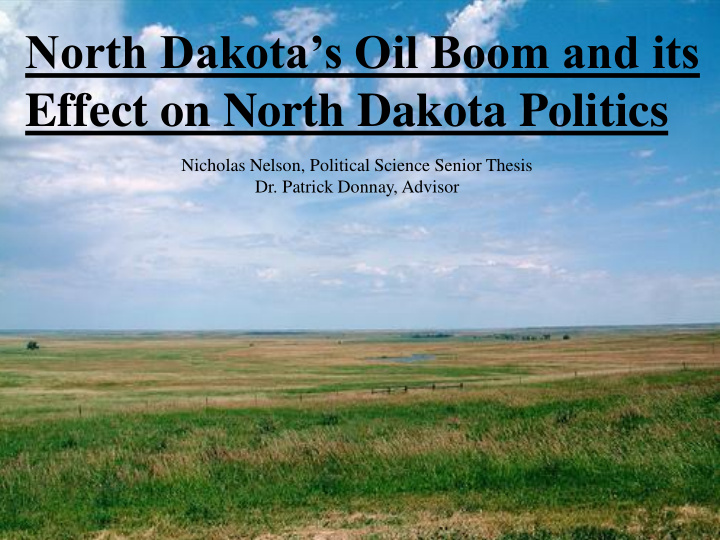



North Dakota’s Oil Boom and its Effect on North Dakota Politics Nicholas Nelson, Political Science Senior Thesis Dr. Patrick Donnay, Advisor
North Dakota will soon produce the second most oil of any U.S. state Gunderson, MPR News What does this mean for North Dakota politics?
“Social Disruption” • Disrupts social structure and patterns Smith 2001, Rural Sociology • Behavioral expectations and social organizations are disrupted by heterogeneity moving into a once homogeneous community Gilmore 1975, A Challenge of Growth Management
Gillette Syndrome • Crime • Fairbanks, Alaska (total crime) +394% • Rock Springs, Wyoming (calls) + 28,000 • The Williston (ND) Police Department is getting more calls now in a month than it used to in a year” CBS Minnesota , 2012 • Health • Rock Springs, Wyoming (health center caseload) +857% • Platte, Wyoming (mental health caseload) +198% • Housing • Supply and Demand $$$$$$$$ • Senior citizens that are on fixed incomes went from paying $300 a month to $3,000” Gunderson 2012, Gunderson 2012, MPR News • Education • Schools outgrow their capacity • Building being converted into temporary schools
Hypothesis As oil production increases, North Dakota counties will become more Democratic
Data Sources ND Dept. of Natural Resources ND Secretary of State U.S. Census Oil and Gas Division
Relationship of Oil Production, Population Changes, and Democratic Vote on Each Other in Oil Producing Counties Oil Change Population Democratic Change Black Change Hispanic Change White Change Change 1 .480 .142 -.099 .413 .220 Pearson Correlation Oil Production .114 .661 .760 .182 .493 Sig. (2-tailed) Change 12 12 12 12 12 12 N .480 1 -.467 .669 * .836 ** .921 ** Pearson Correlation Population .114 .126 .017 .001 .000 Sig. (2-tailed) Change 12 12 12 12 12 12 N .142 -.467 1 -.324 -.247 -.673 * Pearson Correlation Democratic .126 .661 .304 .440 .017 Sig. (2-tailed) Change 12 12 12 12 12 12 N -.099 .669 * -.324 1 .708 * .620 * Pearson Correlation Change Black .304 .760 .017 .010 .032 Sig. (2-tailed) 12 12 12 12 12 12 N .413 .836 ** -.247 .708 * 1 .645 * Pearson Correlation Change .010 .182 .001 .440 .024 Sig. (2-tailed) Hispanic 12 12 12 12 12 12 N .220 .921 ** -.673 * .620 * .645 * 1 Pearson Correlation Change White .024 .493 .000 .017 .032 Sig. (2-tailed) 12 12 12 12 12 12 N *. Correlation is significant at the 0.05 level (2-tailed). **. Correlation is significant at the 0.01 level (2-tailed).
Population Change’s Affect on the Democratic Vote in Non-Oil Producing Counties
Relationship Between Population Change and the Democratic Share of the Vote in Non-Oil Producing Counties of North Dakota from 1992-2012 Population Change Democratic Change Black Change Hispanic Change White Change Pearson Correlation 1 .100 .946 ** .864 ** .996 ** Population Change Sig. (2-tailed) .566 .000 .000 .000 N 35 35 35 35 35 Pearson Correlation .100 1 .103 .108 .074 .566 Democratic Change Sig. (2-tailed) .557 .536 .675 N 35 35 35 35 35 Pearson Correlation .946 ** .103 1 .899 ** .934 ** .557 Change Black Sig. (2-tailed) .000 .000 .000 N 35 35 35 35 35 Pearson Correlation .864 ** .108 .899 ** 1 .827 ** .000 Change Hispanic Sig. (2-tailed) .000 .536 .000 N 35 35 35 35 35 Pearson Correlation .996 ** .074 .934 ** .827 ** 1 .000 Change White Sig. (2-tailed) .000 .675 .000 N 35 35 35 35 35 **. Correlation is significant at the 0.01 level (2-tailed).
Population Increase’s Affect on the Democratic Share of the Vote statewide
The Relationship Between Population Change of the Democratic Share of the Vote Statewide from 1992-2012 Population Democratic Change Black Change Change White Oil Change Change Change Hispanic 1 .114 .944 ** .832 ** .995 ** -.013 Pearson Correlation Population Change Sig. (2-tailed) .417 .000 .000 .000 .925 53 53 53 53 53 53 N -.348 * Pearson Correlation .114 1 .130 .105 .090 .417 Democratic Change .354 .455 .523 .011 Sig. (2-tailed) 53 53 53 53 53 53 N .944 ** .850 ** .933 ** .130 1 -.047 Pearson Correlation .354 Black Change .000 .000 .000 .740 Sig. (2-tailed) N 53 53 53 53 53 53 .832 ** .850 ** .785 ** .105 1 .006 Pearson Correlation .000 Hispanic Change Sig. (2-tailed) .000 .455 .000 .966 53 53 53 53 53 53 N .995 ** .090 .933 ** .785 ** 1 -.022 Pearson Correlation .000 White Change Sig. (2-tailed) .000 .523 .000 .875 53 53 53 53 53 53 N -.348 * Pearson Correlation -.013 -.047 .006 -.022 1 .875 Oil Change .925 .011 .740 .966 Sig. (2-tailed) 53 53 53 53 53 53 N **. Correlation is significant at the 0.01 level (2-tailed). *. Correlation is significant at the 0.05 level (2-tailed).
Conclusion All counties producing oil are becoming more Republican Non-oil producing counties are becoming slightly more Democratic Statewide, North Dakota is becoming very slightly more Democratic However, oil production has a significant relationship on the increase in the Republican vote, dragging down the Democratic Vote
Thank you! Any Questions?
Recommend
More recommend